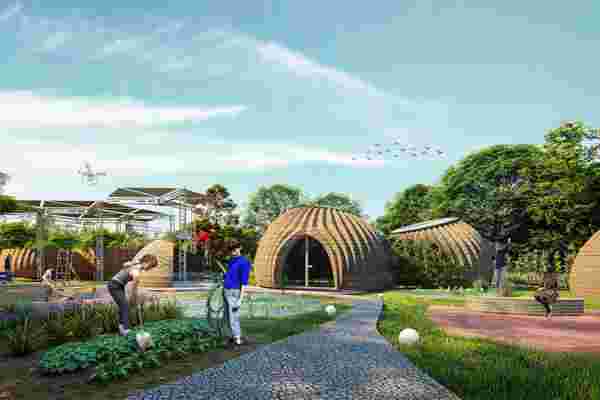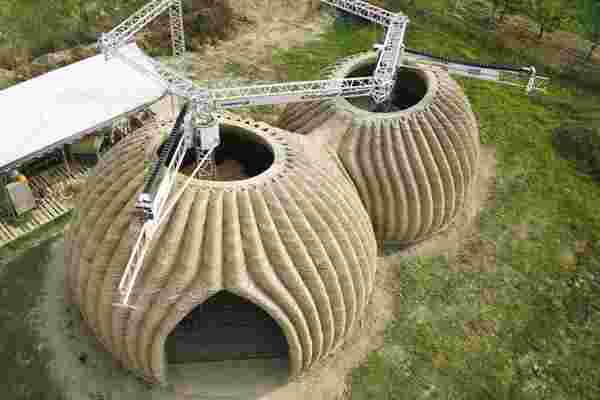We recently featured Justin Chong’s charming, super-minimal Cube home… well he’s back with an alternative version that reworks the usable space to accommodate more storage, sleeping room, a full bathroom and even a laundry area fit with a compact clothes washer/dryer combo! The other design was a lil dark so the most significant addition is built-in, ultra-thin LED lighting accents in inconspicuous places like under the stairs or kitchen shelving.
Designer: Justin Chong
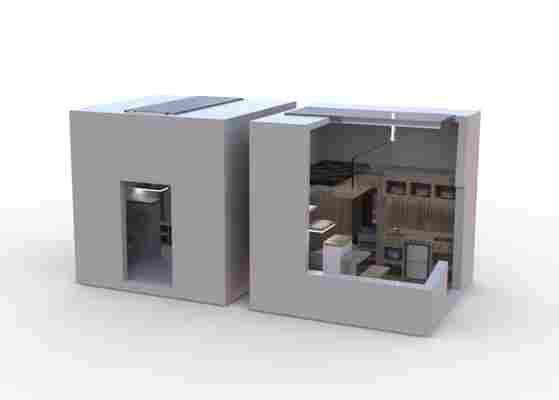
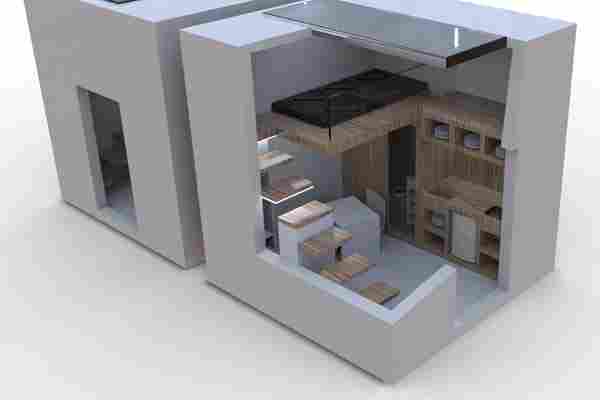
Boston Gets A Boa
Can the Dubai real-estate slump be blamed on ambitious projects that tried to recreate mini magical kingdoms? Don’t know, however that’s not stopped the designers from their creative thinking so let’s overview a challenging project that’s aimed for Boston residents. Christened The Boa (Boston Arcology), this floating city isn’t worried about the threat of rising oceans, because it’s equipped with “techniques of today and has been researched to be totally feasible.” Read on to know more… Highlights of the Boa:
It will be capable of housing 15,000 people distributed in hotels, offices, retail, museums, condominiums, and a new city hall.
The massing of Boa takes its cue from the built environment of Boston proper and as such exudes a rigorous geometric format. That format is further emphasized by the scaling of the golden rectangle whose proportions are: 1: 1.618.
Within this golden rectangle, Boa’s design alignments have a unique relationship with the Boston common. What appear to be random projections of massing are actually fashioned as a vertical construct of the “common.” These diagonals are held in check by a fixed border as if a rigid urban edge.
Because of its scale, Boa is positioned perpendicular to the waterfront, preserving view corridors and general development massing.
Sky gardens will be inserted into the three main towers every 30 floors. These sky gardens provide landscaped glass enclosed atria. In addition to their practical application of additional sunlit units, the “sky gardens” will create a sense of neighborhood presence and support a range of sustainable initiatives. Vertical commuting within Boa will be supported by a series of local and express transfer floors.
Boa is geared to an all pedestrian environment. Accordingly, only select horizontally based areas will be fitted with moving walkways and/or electric train carriers.
Boa is designed to expand the horizon of sustainability and will seek LEED certification.
Boa will eliminate the need for cars within the urban structure to create a carbon neutral entity. Some of these elements are secured wind turbines, fresh water recovery and storage systems, passive glazing system, sky garden heating/cooling vents, gray water treatment, solar array banding panels, and harbor based water turbines.
A massive park system platform (pedestrian only) will be more than double the current green space allocation for the waterfront of Boston.
Boa is a floating city within a city, and is technically feasible, with the method as follows:
The foundation of Boa is a series of poured concrete cells, which are combined to form a buoyant platform. The grid of these cells serves as the foundation for the rigid steel
Superstructure
Though seemingly counter-intuitive, concrete is in fact a viable and durable floating solution. Oil rigs, barges, and even ships from WWII all employed this use of concrete to create buoyant objects. With new self sealing concrete, and other technologies, such structures can be monitored indefinitely.
By proportional height, width, length, and weight, this buoyant platform is estimated to 90 feet, with an additional 15 feet of “buffer.” Assuming approximately 30-40 ft current depth in the ocean bed, a “retaining pool” would be sunk into the harbor, giving a waterline to base dimension of 105 feet. This becomes the fixed “pool” in which Boa floats as water seeks its own level.
Boa is proposed as a three phase master plan. Though capable of program changes and opportunities, the project is geared to a ten year build-out. Because it is built in the harbor, it will have minimum impact on existing functions. Further, Boa is designed not to encroach on existing channels.
Designer: E. Kevin Schopfer, AIA, RIBA
Renderings: Tangram 3DS
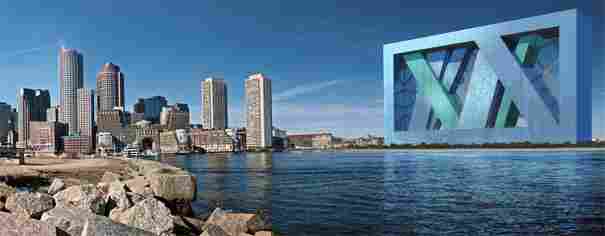
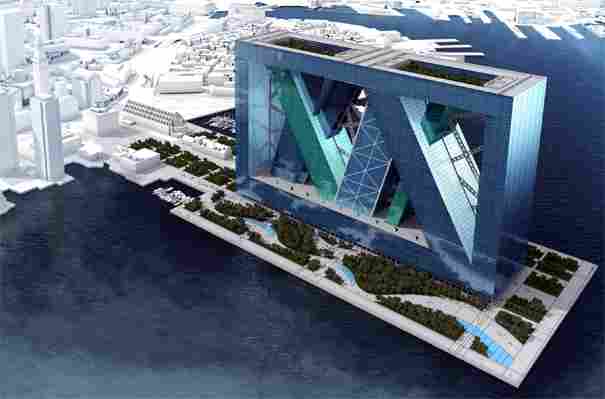
A 3D printed global housing community is being constructed in Italy for sustainable living!
{"title":"Eco-sustainable 3D printed house - Tecla","author_name":"3D WASP","author_url":"https://www.youtubeom/user/wasprojecteam","type":"video","height":"591","width":"1050","version":"1.0","provider_name":"YouTube","provider_url":"https://www.youtubeom/","thumbnail_height":"360","thumbnail_width":"480","thumbnail_url":"https://i.ytimgom/vi/w9sXqxccRPM/hqdefault.jpg","html":"<iframe width="1050" height="591" src="https://www.youtubeom/embed/w9sXqxccRPM?feature=oembed" frameborder="0" allow="accelerometer; autoplay; clipboard-write; encrypted-media; gyroscope; picture-in-picture" allowfullscreen></iframe>","arve_cachetime":"2021-03-05 09:06:45","arve_url":"https://youtu.be/w9sXqxccRPM","arve_srcset":"https://i.ytimgom/vi/w9sXqxccRPM/mqdefault.jpg 320w, https://i.ytimgom/vi/w9sXqxccRPM/hqdefault.jpg 480w, https://i.ytimgom/vi/w9sXqxccRPM/sddefault.jpg 640w"}
Sustainable designs are now taking center stage in the design world as we battle the climate crisis affecting several industries. To implement sustainability in architecture is trickier given the scale of design but if we find the right solutions, the impact will also be big enough to cause ripples of positive changes. Fun fact: it is not the aviation industry but actually the construction industry that contributes to the global greenhouse gas emissions and the difference is 2% vs 39%. In fact, cement alone is responsible for 8% of global greenhouse gas emissions which is why the need for more sustainably constructed housing arose. Mario Cucinella Architects and WASP decided to do something about it and designed TECLA – a completely 3D printed global habitat based on natural materials.
TECLA’s construction started as a prototype in 2019 near Bologna, Italy as a response to pressing societal issues of explosive population growth which inevitably led to a lack of affordable accommodation. TECLA is created using entirely reusable, recyclable materials taken from the local terrain – it aims to be a model for circular housing as well as eco-housing. The habitat has been designed by Mario Cucinella Architects and brought to life by WASP’s engineering and printing tech. TECLA is set to be the first house to be entirely 3D-printed using locally sourced clay which has been used for centuries in countries like India as a cost-effective and environmentally friendly alternative to cement – clay is a biodegradable and recyclable material that will make the building a zero-waste structure. The project’s name comes from an imaginary city described by writer Italo Calvino, it will be built using multiple collaborative 3D-printers all working at the same time – a feat in itself given the scale.
The housing is designed and built to adapt to multiple environments as well as be suitable for self-production using WASP’s ‘maker economy starter kit’. This reduces industrial waste and boosts national + local economies using a sustainable model that involves the residents which will strengthen the community along with the environment’s health. It was all developed using extensive research undertaken by the SOS (School Of Sustainability), an institution founded by Mario Cucinella himself. This valuable research explored the cause and effects of homelessness based on case studies in locations with different climates. As a result, the two firms designed a resilient housing community for any climate while being energy-efficient, unlike traditional housing and construction models. TECLA is also being looked at as a case study that can become the basis for off-the-grid autonomous eco-cities – the future is here!
Designers: Mario Cucinella Architects and WASP
